Crickets are somewhat grasshoppers and more closely related to katydids or bush crickets (family Tettigoniidae). They have somewhat flattened bodies and long antennae. There are about 900 species of crickets. They tend to be nocturnal and are often confused with grasshoppers because they have a similar body structure including jumping hind legs.
Crickets are omnivores and scavengers feeding on organic materials, as well as decaying plant material, fungi, and some seedling plants. Crickets also have been known to eat their own dead when there is no other source of food available. Crickets mate in late summer and lay their eggs in the fall. The eggs hatch in the spring and they usually hatch in groups of 2,000. Female crickets have a long needlelike egg-laying organ.
Crickets are popular as a live food source for carnivorous pets like frogs, lizards, salamanders, and spiders. Feeding crickets with nutritious food in order to pass the nutrition onto animals that eat them is known as gut loading. Crickets are also eaten by humans in some cultures
Crickets are pests that can destroy a nation’s economy. They can destroy a whole crop field. In some cases they can even damage fabric and grain stock. They may carry some germs which can cause skin disorder. Crickets sometimes causes disturbance in traffic too.
Control & Prevention Tips
Crickets can be controlled by using insecticide and that too by a professional. It is better to consult a professional pest control company.

